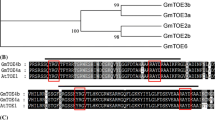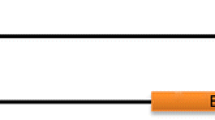Abstract
Soybean is a short-day plant and its flowering process can be reversed when switching from short-day to long-day conditions. Flowering reversion provides a useful system to study the flowering process in both forward and backward directions. In this study, we optimized a soybean flowering reversion system using a photoperiod-sensitive cultivar Zigongdongdou. Three types of terminal structures were found during flowering reversion: reversed terminal raceme (RTR), short terminal raceme (STR), and vegetative terminal (VT). The relative frequency of these terminal structures during flowering reversion under long day was dependent on the duration of the prior short day (SD) pretreatment. This process is phytochrome dependent and young plants were more susceptible to flowering reversion. Leaf removal increased the minimal SD period needed for the induction of STR. To demonstrate the application of this system, we studied the patterns of in situ expression of the GmNMH7 gene during flowering development and reversion. NMH7 family members encode MADS-box proteins and are unique in legume families since their expression can be detected in both developing flowers and nodules. In situ hybridization experiments using plants grown under different photoperiod cycles provided several lines of evidence supporting a close relationship between GmNMH7 gene expression and floral development in soybean. Furthermore, it seems that GmNMH7 may participate in flower development at different stages. Interestingly, the expression pattern of GmNMH7 in root nodules was also found to be regulated by photoperiod. These results support the notion that the photoperiod sensitive GmNMH7 gene may play multiple roles in growth and development in soybean.








Similar content being viewed by others
Abbreviations
- ZGDD:
-
Zigongdongdou
- GmNMH7:
-
Glycine max NMH7
- NMH7:
-
Nodule MADS-box Homologue 7
References
Alvarez-Buylla ER, Pelaz S, Liljegren SJ, Gold SE, Burgeff C, Ditta GS, de Pouplana LR, Martinez-Castilla L, Yanosfsky MF (2000) An ancestral MADS-box gene duplication occurred before the divergence of plants and animals. Proc Natl Acad Sci USA 97:5328–5333
Battey NH, Lyndon NH (1990) Reversion of flowering. Bot Rev 56:163–189
Doyle JJ (1998) Phylogenetic perspectives on nodulation: evolving views of plants and symbiotic bacteria. Trends Plant Sci 3:473–478
Han T, Gai J, Wang J, Zhou D (1998) Discovery of flowering reversions in soybean plant. Acta Agron Sinica 24:168–171
Han T-F, Wang J (1995) Studies on the post-flowering photoperiodic reversions in soybean plant. Acta Agronomica Sin 24:168–171
Heard J, Dunn K (1995) Symbiotic induction of a MADS-box gene during development of alfalfa root nodules. Proc Natl Acad Sci USA 92:5273–5277
Heard J, Caspi M, Dunn K (1997) Evolutionary diversity of symbiotically induced nodule MADS box genes: characterization of nmhC5, a member of a novel subfamily. Mol Plant-Microbe Interact 10:665–676
Hoagland DR, Arnon DI (1938) The water-culture method for growing plants without soil. Calif Agric Expt Sta Circ 347:1–39
Kumar S, Tamura K, Jakobsen IB, Nei M (2001) MEGA2: molecular evolutionary genetics analysis software. Bioinformatics 17:1244–1245
Lame SL, Leopold AC (1960) Reversion from flowering to the vegetative state in Xanthium. Amer J Bot 47:256–259
Lame SL, Leopold AC (1961) Reversion and reinduction of flowering in Perilla. Amer J Bot 48:306–310
Li X, Wu C, Ma Q, Zhang S, Li C, Zhang X, Han T (2005) Morphology and anatomy of the differentiation of flower bud and the process of flowering reversion in soybean cv. Zigongdongdou. Acta Agron Sin 31:1437–1442
Lord EM, Eckard KJ (1987) Shoot development in Citrus sinensis L. (Washington navel orange). II. Alteration of developmental fate of flowering shoots after GA3 treatment. Bot Gaz 148:17–22
Pouteau S, Nicholls D, Tooke F, Coen E, Battey N (1997) The induction and maintenance of flowering in Impatiens. Development 124:3343–3351
Saedler H, Becker A, Winter K-U, Kirchner C, Theissen G (2001) MADS-box genes are involved in floral development and evolution. Acta Biochim Pol 48:351–358
Schwarz-Sommer Z, Huijser P, Nacken W, Saedler H, Sommer H (1990) Genetic control of flower development by homeotic genes in Antirrhinum majus. Science 250:931–936
Thompson JD, Higgins DG, Gibson TJ (1994) CLUSTAL W: improving the sensitivity of progressive multiple sequence alignment through sequence weighting, position-specific gap penalties and weight matrix choice. Nucl Acid Res 22:4673–4680
Thompson PA (1963) Reversal of photoperiodic induction of strawberries with maleic hydrazide. Nature 200:146–148
Tsai K, Tang S-H (1965) Studies on the reversion from reproductive to vegetative state of plants. Acta Phytophysiol Sinica 2:375–384
Washburn CF, Thomas JF (2000) Reversion of flowering in Glycine max (Fabaceae). Am J Bot 87:1425–1438
Xu YY, Chong K, Xu ZH, Tan KH (2001) Expression patterns of a vernalization-related genes responding to jasmonate. Acta Bot Sin 43:871–873
Zahn LM, Leebens-Mack J, DePamphilis CW, Ma H, Theissen G (2005) To B or not to B a flower: the role of DEFICIENS and GLOBOSA orthologs in the evolution of the angiosperms. J Hered 96:225–240
Zucchero JC, Caspi M, Dunn K (2001) ngl9: a third MADS box gene expressed in alfalfa root nodules. Mol Plant-Microbe Interact 14:1463–1467
Acknowledgements
This work was supported by the grants from the National Natural Science Foundation of China (30471054, 30490250), State Key Basic Research and Development Plan of China (2002CB111301), and National High Technology Research and Development Program of China (2003AA207060, 2004AA241060) to T.H.; by the grant from the Chinese Academy of Sciences Innovation Fund to K.C., and by the grants from Hong Kong UGC Area of Excellence on Plant & Fungal Biotechnology and CUHK Direct Grant to H.-M.L.
Author information
Authors and Affiliations
Corresponding authors
Additional information
C. Wu and Q. Ma contributed equally to this work.
Rights and permissions
About this article
Cite this article
Wu, C., Ma, Q., Yam, KM. et al. In situ expression of the GmNMH7 gene is photoperiod-dependent in a unique soybean (Glycine max [L.] Merr.) flowering reversion system. Planta 223, 725–735 (2006). https://doi.org/10.1007/s00425-005-0130-y
Received:
Accepted:
Published:
Issue Date:
DOI: https://doi.org/10.1007/s00425-005-0130-y




